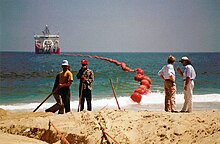Cable layers
A cable lay is a work ship that can lay submarine cables through a body of water.
Sequence of laying a submarine cable
Before the use of the cable layer, survey vessels equipped with sonar systems to explore the nature of the seabed travel a possible route at low speed (approx. 5 km / h). The aim is to find a route in which the cable can lie protected on or in the sea bed.
It takes about two weeks to load and accommodate the cable on the ship. The cable is laid layer by layer and with great care on several large cable drums inside the cable layer (not wound!).
During use, the speed of the cable lay must be precisely matched to the nature of the seabed in order not to damage the cable. A complex control coordinates the speed of the ship over the ground (nowadays measured by means of a GPS receiver on board ) and the speed at which the cable is removed from the cable drum. In addition to the force acting on the cable and the angle of immersion of the cable, this control system takes into account the water depth and the height profile of the route.
The submarine cable laid by the cable laying ship is washed into the sea floor by means of water jets , especially near the coast, by the cable laying plow that has been pulled. The submarine cable is better protected from damage by anchors , trawls and other things.
Laying submarine cables from the coast (animation)
Cable plow for laying submarine cables on the seabed
Repair of a submarine cable (animation)
Important cable layers
Cable layer Nostag 10 from the front
Cable lay Léon Thévenin
One of the most famous cable layers was the Great Eastern , built in 1854 , a very hapless ship. Very unsuccessful as a passenger steamer, only to be used temporarily as a cable layer. The first ship designed and successfully used as a cable layer was the HC Oerstedt of Store Nordiske Telegraph Selskab, built by Burmeister & Wain in Copenhagen in 1872 . Two years later, the much more modern Faraday followed . The ship, which was put into service in 1874, combined all the typical features of a cable lay for the first time and thus shaped all subsequent designs. The first German cable layer was Von Podbielski, built in Scotland in 1899 .
One of the largest cable layers built is Long Lines, baptized in 1962 and owned by the Transocean Cable Ship Company . It was designed by Gibbs & Cox in New York and built at the Schlieker shipyard in Hamburg. She has two full decks and twelve watertight bulkheads. At the bow are the cable pulleys and the buoy racks, a little further back the two buoy cranes and the cable motor. Because of the necessary maneuverability, the ship is turbo-electrically powered. Each of the steam turbines drives a drive generator, a generator for the general power supply and one for the cable motor via a gearbox . The electric drive motors deliver 2830 kW (3850 hp) each at 131 rpm. The steam is generated in two boilers at a pressure of 42 bar. The ship has a bow thruster with an output of 750 hp. The Long Lines can load around 3700 km of submarine cable, which it normally extends over the stern at a speed of 8 kn .
literature
- Vierus, Dieter: Cable layers from all over the world . 1st edition. transpress, Berlin 1989, ISBN 3-344-00394-1 .














